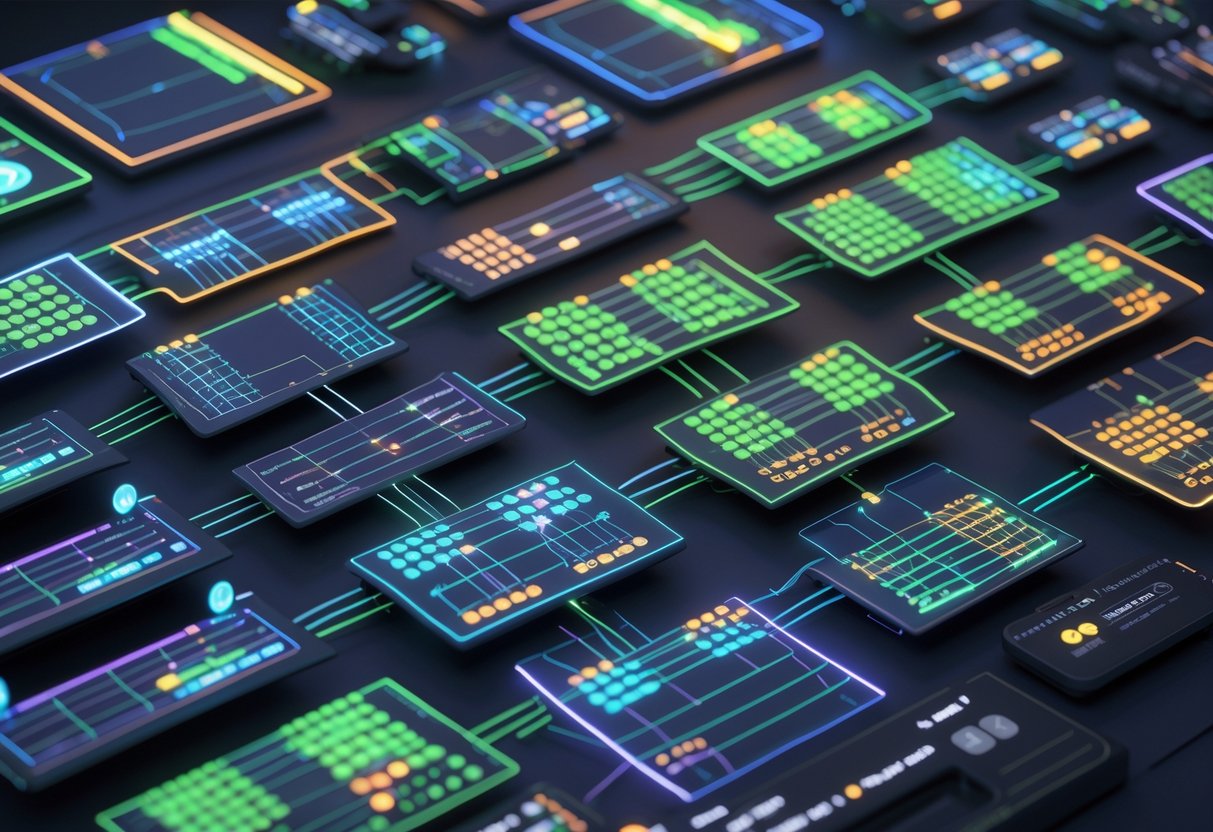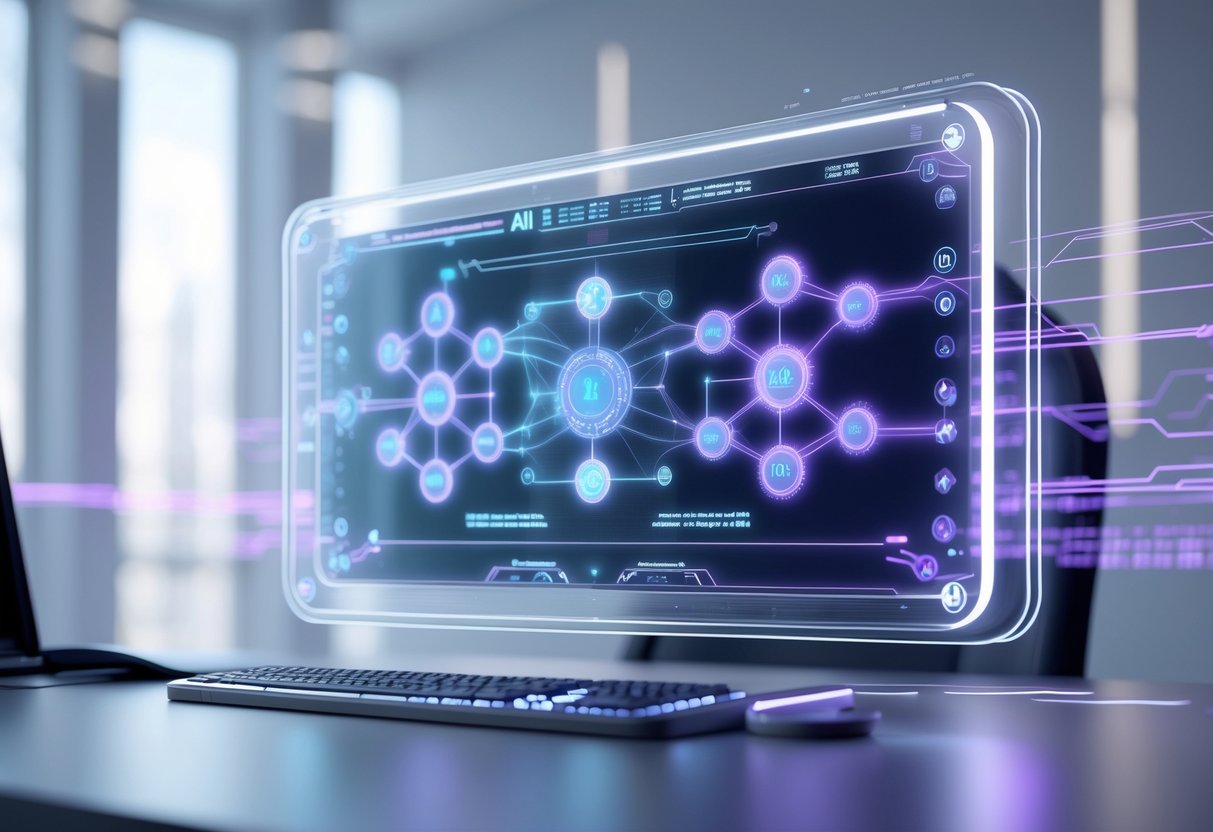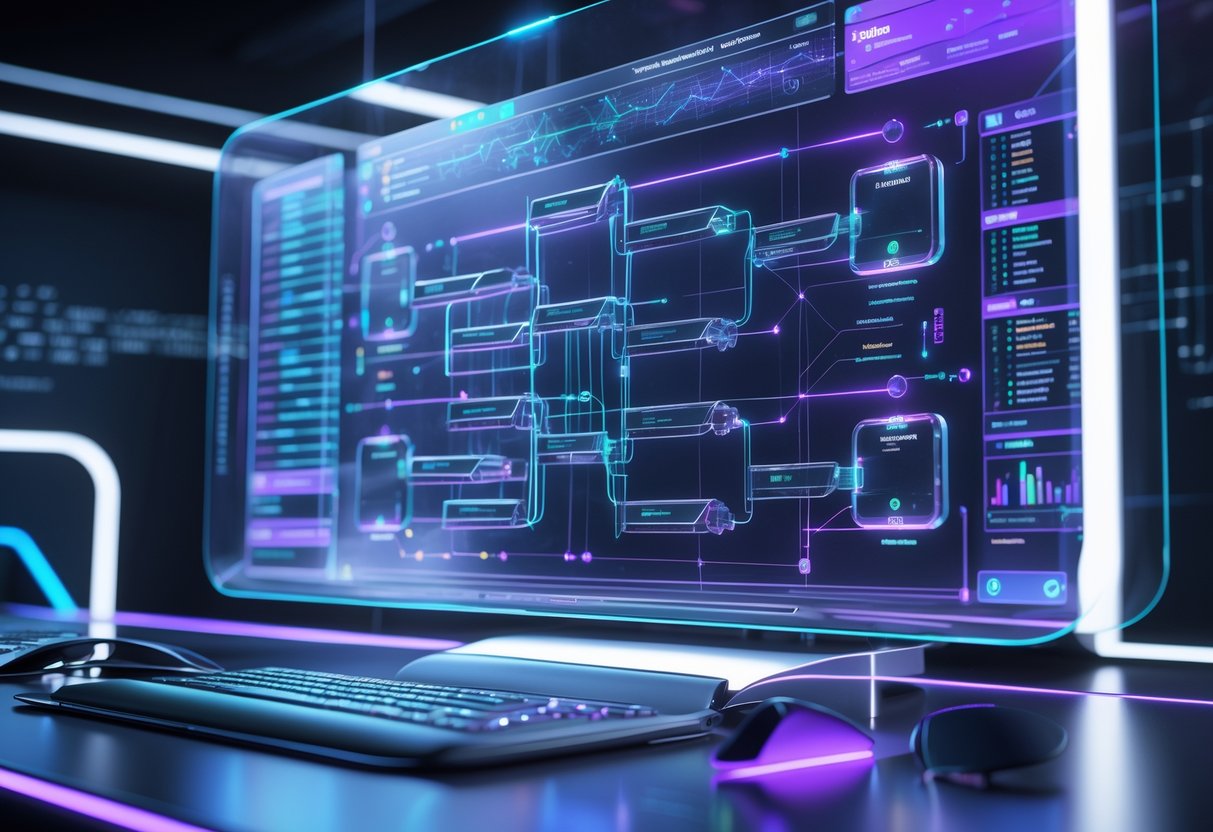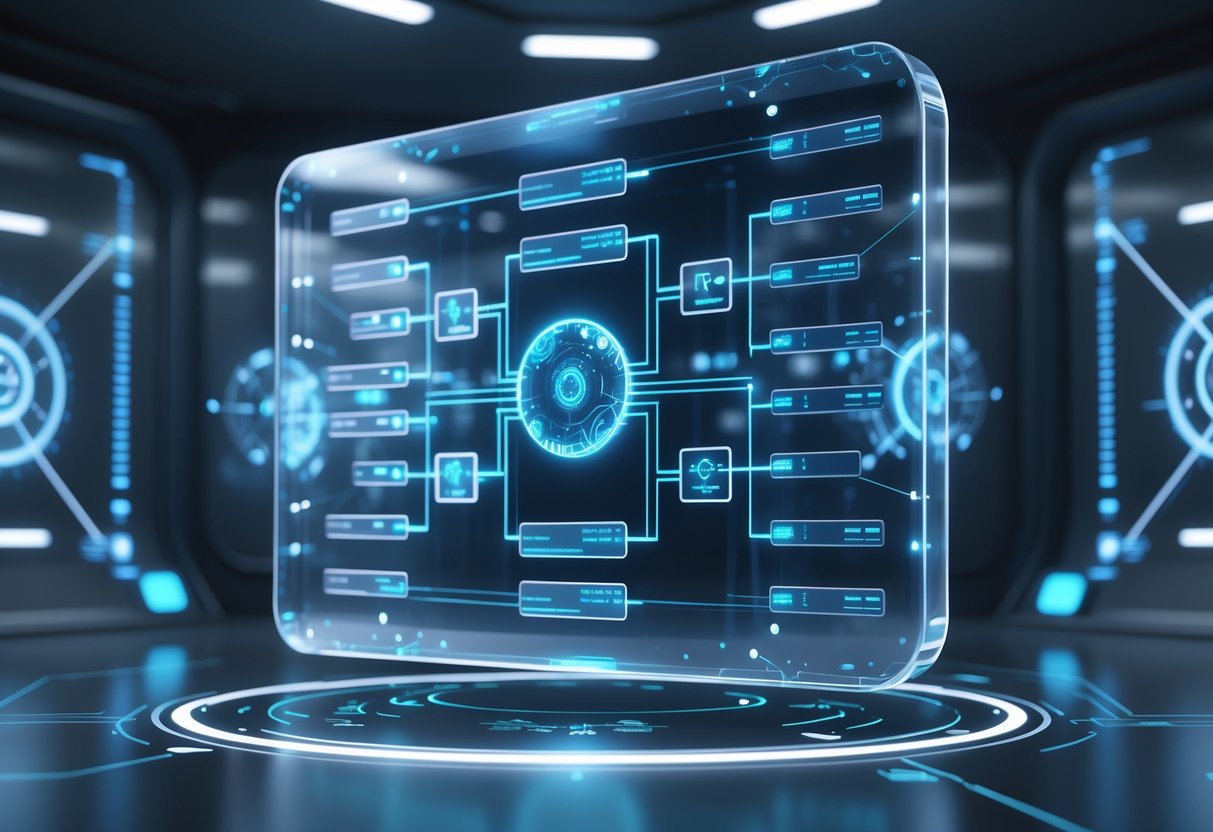AI-Generated Tournament Brackets: The Ultimate Guide
Updated On: November 13, 2025 by Aaron Connolly
What Are AI-Generated Tournament Brackets?
AI-generated tournament brackets use machine learning algorithms to create and organise gaming tournaments automatically. They look at data like player rankings, past performance, and match history.
These systems take away the need for manual bracket building. They help ensure fair matchups and cut down on human bias in seeding decisions.
Definition and Purpose
AI-generated tournament brackets basically build tournament structures for you using artificial intelligence. The technology digs through tons of player data to figure out the best matchups and seeding.
Back in the day, tournament organisers had to seed players and set up matchups by hand. That process took forever and often let bias or mistakes creep in.
Now, AI bracket systems process data in minutes. They look at:
- Past match results
- Player rankings
- Performance trends
- Head-to-head stats
The main goal here is efficiency and fairness. With tournaments sometimes drawing hundreds or thousands of players, doing it by hand just isn’t realistic.
If you want to try it, plenty of online platforms like Challonge offer basic AI bracket generation for free. It’s a good way for small gaming communities to see what the tech can do.
Key Terminology Explained
It helps to know some AI bracket lingo if you’re diving into tournament platforms.
Seeding means ranking players before the tournament kicks off. Higher seeds usually play lower seeds early on, which helps keep things competitive.
Bracket formats come in a few main types:
- Single elimination: Lose once and you’re out.
- Double elimination: You get a second chance, but two losses send you home.
- Round robin: Everyone plays everyone.
Matchmaking algorithms decide who plays whom. They use skill ratings, past results, and tournament rules to try and set up good matches.
Dynamic adjustments let AI change brackets on the fly. If a top player drops out, the system can rebalance things automatically.
Predictive analysis is where AI tries to predict match outcomes. The idea is to boost viewer excitement and keep things fair.
How AI Brackets Differ from Manual Brackets
AI and manual bracket creation feel pretty different for both organisers and players.
Speed stands out right away. A 64-player bracket might take hours by hand, but AI can crank it out in under five minutes.
AI uses real data, so it cuts down on bias. Humans sometimes favour certain players or regions, even if they don’t mean to.
AI can crunch way more data than a person ever could. It checks thousands of match records at once, while humans usually only look at recent results or basic rankings.
If someone drops out due to network issues, AI adapts the brackets instantly. No need for frantic manual reshuffling.
Automated systems almost never make mistakes like duplicate pairings or bad seeds. Manual entry errors just don’t happen as much.
Just a heads up: Basic AI tools sometimes miss subtle things, like regional skill gaps or meta shifts that experienced organisers would catch.
Human oversight still matters for big or complicated tournaments with special rules.
How AI Bracket Makers Work
AI tournament bracket generators mix machine learning with structured programming to automate bracket creation from start to finish. These systems handle everything—ranking participants, simulating matches, and analysing data with smart algorithms.
Underlying Technologies
AI bracket makers depend on a few key technologies working together. Large language models like Gemini look at participant data and make ranking choices based on performance history, ratings, or whatever criteria you set.
Machine learning algorithms sift through tons of tournament data to predict match results. They factor in past performance, head-to-head records, and current form to simulate what might happen.
Natural language processing lets these systems understand your instructions. If you say, “shooting ability matters most,” the AI applies that throughout the bracket simulation.
Computer vision can read visual data like team logos or player images. Some advanced systems even make custom championship graphics using AI image tools.
Database management systems keep participant info organised and easy to access. That way, the bracket maker doesn’t slow down, even with hundreds of players.
Typical Workflow Overview
AI bracket creation usually follows a pretty simple sequence. First, you punch in your tournament theme, number of participants, and any special rules.
The system spits out a ranked list of everyone playing. It can use your data, web results, or its own knowledge to rate each competitor.
Seeding happens automatically, using tried-and-true methods like the S-curve from NCAA basketball. This helps keep regions balanced.
Match simulation goes round by round. Each matchup gets its own AI analysis, looking at seeds, special rules, and the odds of an upset.
The system generates a final bracket image. Some versions let you hover over matches to see why the AI picked certain winners.
You get multiple output formats—static images, interactive HTML, or text summaries that explain how the tournament played out.
Automation in Seeding and Pairing
AI handles all the math behind fair seeding, so you don’t have to. Controlled generation puts players in the right bracket spots based on their rankings.
The system spreads top seeds across different regions, so strong players don’t all end up on one side. This keeps things interesting.
Smart pairing algorithms figure out matchups for each round. The AI can factor in geography, old rivalries, or any custom rules you set.
If someone drops out, the bracket maker reshuffles everything in real time. No manual recalculation needed.
Quality checks run in the background. The AI makes sure everyone is unique, seeded right, and advancing correctly—so the bracket structure stays solid.
Popular Tournament Formats Supported by AI

AI tournament generators can handle three main bracket types that cover most gaming events. Each format works best for different tournament goals, whether you want a quick knockout or a full league.
Single Elimination Tournaments
Single elimination is the simplest format for AI systems to handle. If you lose, you’re out—easy as that.
AI does a great job seeding these brackets. It checks rankings and past performance to keep matchups fair. Top seeds usually play lower-ranked opponents first.
Most AI generators can create single elimination brackets for up to 128 players in about 30 seconds.
This format is ideal for:
- Weekend events with tight schedules
- Big groups that need quick whittling down
- Casual tournaments where you want to keep it simple
AI balances the bracket by itself. It avoids the mess where all the best players end up on one side.
One downside: Single elimination can feel rough for players who travel a long way only to lose their first match.
Double Elimination Options
Double elimination gives everyone a second shot through a losers’ bracket. AI tracks two tournament trees at once—one for undefeated players, another for those with a loss.
The system sets up an upper bracket for winners and a lower bracket for those who lose once. You have to lose twice to be out, except in the grand final, where the upper bracket winner only needs one win.
AI handles the tricky scheduling. It figures out when losers’ bracket matches should run and manages the crossover points.
You’ll usually see this format in:
- Fighting game tournaments with lots of upsets
- Esports events with big prizes
- Competitive scenes where players are closely matched
Just remember: Double elimination tournaments take about 60% longer than single elimination.
This format keeps more players in longer and helps maintain competitive integrity. AI keeps the bracket flowing, even with all the extra rules.
Round Robin Variations
Round robin formats make everyone play everyone else at least once. AI systems build detailed schedules to keep things fair and spread out matches.
Standard round robin has each team play every other team once. AI figures out the number of matches and creates a schedule that avoids burnout.
AI also supports:
- Double round robin (home and away)
- Swiss system (players face others with similar records)
- Group stages (small round robins combined)
AI sorts out tie-breakers automatically. It uses head-to-head results, goal difference, or points, depending on your sport.
Keep in mind: Round robin tournaments take a lot more matches than elimination formats.
This format guarantees more games for everyone. AI tries to optimise the schedule to cut down on venue conflicts and travel when possible.
It’s best for league-style competitions, skill assessment, and any event where participant experience matters more than speed.
Choosing an AI Tournament Bracket Generator

Picking the right AI tournament bracket generator really affects your event planning. Look for solid automation, user-friendly design, and customisation that fits your tournament style.
Important Features to Look For
Automated bracket creation is the key feature here. The system should handle seeding automatically, using rankings or performance data you give it.
Make sure the tool supports multiple tournament formats. Single elimination, double elimination, and round robin are must-haves. Swiss system support is a nice bonus for bigger events.
Real-time updates help keep things running smoothly. The bracket maker should move winners forward and update matchups on its own.
Smart scheduling avoids conflicts. The AI should look at things like venue availability and time zones when building the schedule.
Export features matter. You want to be able to share brackets as PDFs, images, or web links—whatever works for your group.
Good systems catch errors before they become a problem. They flag duplicate entries, bad seeds, or impossible matchups.
User Experience and Accessibility
Clean, easy-to-use interfaces save everyone time. Go for generators that guide you through setup step by step, not ones that dump a ton of menus on you.
Mobile compatibility is a must now. The best bracket makers work just as well on your phone or tablet as on a computer.
Quick setup makes a big difference. You should be able to create a basic bracket in five minutes or less without a lot of typing.
Look for tools that keep everyone in the loop automatically. Notifications about match times, results, and updates cut down on admin headaches.
Multi-language support is important for international tournaments. If your event draws a global crowd, don’t skip this.
Reliable customer support helps when things go sideways. Live chat, good documentation, or active forums can save your event if you hit a snag.
Customisation Capabilities
Visual customisation lets you match your tournament’s branding. The best generators let you tweak colours, fonts, and layouts for a professional look.
Flexible structure options are important. Your tool should handle different group sizes, byes, and seeding preferences without locking you into a template.
Advanced scoring systems matter for different games and sports. Whether you need best-of-three, points-based, or time-based scoring, make sure you can set it up.
Integration is a big plus. Look for generators that connect with streaming, registration, or stats tracking tools you already use.
Data export options help you keep records. Good platforms let you download participant lists, match results, or full bracket histories in different formats.
Custom rules matter for sport-specific needs. The system should handle unique tiebreakers, overtime, or qualification rules if you need them.
Benefits of Using AI for Bracket Creation

AI tournament bracket generators make organising competitions way easier. These tools bring real advantages in speed, accuracy, and participant experience that manual brackets just can’t match.
Speed and Efficiency
Traditional bracket creation can take hours, sometimes even days. We’ve all watched tournament organizers hunched over spreadsheets, trying to place teams and spot conflicts. AI just flips the script here.
A tournament bracket generator can process hundreds of participants in minutes. The system considers team rankings, regional restrictions, and scheduling needs right away. What used to eat up an entire weekend now happens in real-time.
For bigger tournaments, the time savings are wild. A 64-team football competition that once needed 8 hours of manual work now gets perfect brackets in under 5 minutes.
This efficiency sticks around after setup too. If teams drop out or schedules shift, AI reshuffles everything on the fly. No more emergency meetings or frantic calls. The system adapts instantly and keeps the tournament on track.
Many free tournament bracket tools now come with automated features. Organizers get to focus on the participant experience instead of paperwork. During peak tournament season, that speed matters a lot, especially when multiple events are running at once.
Error Prevention
Human error in bracket creation causes major headaches. We’ve all seen tournaments fall apart from bad seeding, duplicate matchups, or scheduling disasters. AI just wipes out those mistakes.
Advanced algorithms check every placement decision. The system flags problems before they happen. Scheduling conflicts, impossible travel, and unfair advantages get caught right away.
AI looks at factors people often forget. Time zones, venue capacity, referee schedules, equipment needs—all of it feeds into the process and helps avoid last-minute chaos.
Double-elimination and round-robin formats get messy fast when done by hand. AI handles those complicated structures without breaking a sweat. Every path through the bracket stays mathematically accurate.
Bracket errors can seriously damage a tournament’s reputation. Participants lose trust if they get unfair matchups or impossible schedules. AI keeps those failures from happening, which is a lifesaver for credibility.
Enhanced User Engagement
People expect a professional tournament experience these days. AI-generated brackets deliver that polished look and feel, building excitement and trust among competitors.
Real-time updates keep everyone in the loop. Participants get instant notifications about schedule changes, opponent assignments, and venue details. This cuts down on confusion and support questions.
Visual bracket displays from AI look sharp and inviting. Clean formatting and logical flow make it easy for participants to share brackets with friends. That kind of organic buzz can really expand a tournament’s reach.
AI can personalize the experience, too. It highlights player paths, suggests warm-up times, and even offers opponent research. These little touches make the tournament memorable.
Social media integration takes engagement up a notch. AI-generated brackets are built for sharing, and participants love showing off their tournament journey. That brings in more players and even sponsors.
Organizers get access to advanced analytics. Which matchups draw the most attention? When does engagement spike? These insights help make the next tournament even better.
Managing Tournaments with AI Tools

Modern AI tournament management platforms do it all—from live score updates to automatic participant notifications. These tools track match progress in real-time and give organizers detailed analytics for smarter future events.
Real-Time Updates and Progress Tracking
AI-powered systems update match results instantly everywhere. Enter a score, and the system updates the entire bracket and notifies everyone affected about their next matches.
These platforms track a bunch of data points at once. Live scoring, bracket progression, and participant status all update automatically. Some tools even predict when matches will finish based on current progress.
Real-time tracking helps dodge common tournament delays. The AI spots matches running late and can shift start times for upcoming rounds to keep things moving.
Quick win: Most AI tournament tools have mobile apps, so organizers can update scores from anywhere, even in the middle of the action.
Participant Communication
AI tournament generators send personalized messages to competitors about match schedules, venue changes, and results. This takes care of the endless “when’s my next game?” questions that can swamp organizers.
Automated notifications cover match reminders, bracket updates, and elimination alerts. The AI sends these via email, SMS, or push notification, depending on what participants prefer.
Smart communication features help set expectations. The system can estimate wait times between matches and ping participants if there are delays.
Many platforms include multi-language support for international events. The AI translates key info into each participant’s chosen language.
Automated Results and Analytics
Tournament analytics now go way beyond just win-loss records. AI tools analyze match durations, spot scheduling logjams, and track participant satisfaction throughout the event.
Performance data includes average match times, the most popular slots, and venue usage rates. Organizers use this info to plan better tournaments next time.
Post-tournament reports generate automatically within hours. These include bracket visuals, participation stats, and recommendations for improvement.
Warning: Free AI tournament tools usually keep analytics pretty basic. Premium versions offer deeper reporting, which is worth it for larger events.
Some platforms even tie in with streaming services, tracking viewership data alongside tournament results for a full picture.
How to Create a Free AI-Generated Tournament Bracket
Creating a free AI-generated tournament bracket only takes a few minutes if you pick the right platform. Most tools ask a handful of questions about your event, then automatically set up fair matchups based on team rankings or random seeding.
Step-by-Step Guide
Start by picking your tournament type and format. Most AI bracket generators want to know if you’re running a sports or gaming event first.
Choose between single elimination, double elimination, or round robin. Single elimination is quick and simple. Double elimination gives teams a second shot. Round robin makes sure everyone gets to play more matches.
Add your participants next. Most platforms let you enter teams manually or import a list. You can usually add up to 64 teams for free.
Set your seeding preferences. AI tools can rank teams based on past performance, or you can randomize seeds or set them yourself.
Generate your bracket instantly. The AI creates balanced matchups and schedules in seconds. Most tools display a visual bracket you can download or share online.
Review and tweak the results. Add match dates, venues, or special rules before locking things in. Some platforms let you adjust specific matchups if you need to.
Top Free Bracket Platforms
Challonge is probably the most complete free bracket generator out there. It supports unlimited participants and multiple tournament formats at no cost.
The platform handles automated bracket creation, match reporting, and live updates. Teams can check results and upcoming matches through shared links.
ScoreLeader offers free bracket generation with smart scheduling. It balances venue use and rest times between matches automatically.
Their AI takes match durations and team availability into account when creating fixtures. This stops the usual scheduling mess that comes with manual brackets.
Vondy’s AI Tournament Generator builds custom brackets for sports and gaming events. The tool asks about your tournament needs before generating the results.
ESPN and other sports platforms have basic bracket makers, but they’re pretty limited when it comes to AI features.
Sharing and Collaboration
Export your finished bracket as a PDF for printing or offline use. Most platforms make clean, professional brackets that are ready to display.
Share live brackets by web link. Participants can bookmark the URL to check schedules and results in real-time. Updates show up automatically as matches finish.
Enable team self-reporting if you trust participants to enter their own results. This frees up organizers during busy tournament days.
Set up email notifications for key updates. Teams get alerts about upcoming matches or bracket changes. Some platforms even send SMS reminders.
Use collaborative editing if you’re working with other organizers. Give admin access to co-organizers so they can update results and help manage disputes.
Applications of AI Bracket Generators

AI bracket generators are shaking up tournament organization across a bunch of industries. These tools create fair matchups for traditional sports, streamline massive esports competitions, and help schools run academic contests without a hitch.
Sports Competitions
Traditional sports organizations use AI bracket generators to handle complex tournament setups. These systems look at team rankings, past performance, and locations when creating matchups.
Professional leagues get automated schedules that cut down travel costs. The AI checks team locations and builds brackets that minimize long trips early on.
Local sports clubs can run slick tournaments without paying for outside help. The software takes care of seeding and updates brackets after each match.
Key features for sports include:
- Strength of schedule calculations
- Regional grouping for easier travel
- Injury report integration for fair seeding
- Weather checks for outdoor events
Many amateur leagues say they save 10-15 hours per tournament by using AI generators instead of going manual.
Esports and Gaming
Esports tournaments can have hundreds or thousands of players—doing brackets by hand is just not realistic. AI systems make these huge events manageable.
Online tournaments get automated player matching based on skill and connection quality. The AI keeps players in similar regions together to cut lag.
Gaming cafés and local venues use these tools for weekly competitions. The software tracks player stats and builds balanced brackets to keep things competitive.
Popular features include:
- Skill-based seeding using game rankings
- Time zone matching for global events
- Platform compatibility checks
- Anti-cheat tools for fair play
Tournament organizers have cut setup time from days to minutes with AI bracket generators, especially for big esports events.
Academic and Club Events
Schools and universities use AI bracket generators for debates, quiz bowls, and science fairs. These events need careful balancing of skill levels and expertise.
Debate tournaments avoid repeat matchups and make sure teams face opponents with similar abilities. The software even tracks speaking times and judge feedback for better seeding next time.
Academic competitions like math olympiads use AI to build brackets from test scores and regional data. This keeps things fair across different schools.
Common academic features include:
- Grade level separation for fairness
- Subject expertise matching
- School size balancing for even competition
- Judge scheduling to keep things running smoothly
Student groups have seen more participation when tournaments feel fair and organized thanks to AI brackets.
Customisation and Personalisation Features

AI-powered bracket makers offer tons of visual customization and advanced rule settings so organizers can create unique events. These tools fit right in with existing brands and adapt to whatever the tournament needs.
Visual Themes and Styling
Modern bracket generators let you customize way more than just colors. You can tweak layouts, fonts, team logos, and backgrounds to match your tournament’s vibe.
Core visual elements include bracket structure (single elimination, double elimination, round robin), custom color schemes for each stage, and team badges or player avatars. Most AI tools automatically resize things for desktop and mobile.
Advanced styling lets you upload custom backgrounds, add sponsor logos, and adjust bracket spacing for better readability. Some platforms even have themes for popular games like FIFA, League of Legends, or Counter-Strike.
Real-time previews show exactly how brackets will look before you hit publish. This helps avoid visual confusion or anything that could make your event look less professional.
Advanced Rules and Preferences
AI bracket makers handle complex tournament rules with ease. You can set custom scoring, tiebreakers, and qualification rules that automatically shift the bracket as needed.
Seeding algorithms can focus on recent performance, historical results, or regional rankings. The AI crunches this data to create balanced brackets that keep top competitors in the mix longer.
Dynamic rule adjustments take care of unexpected stuff like player dropouts, technical issues, or schedule changes. The system reshuffles everyone else without wrecking the tournament.
Format flexibility means you can mix group stages with knockout rounds, or use Swiss-system pairings for longer events. You can set minimum games per participant, max tournament duration, or venue capacity—whatever fits your event.
Branding and Integration Options
Professional tournament organisers want brackets that fit right into their websites, streaming setups, and registration systems without any fuss. AI-powered tools these days offer tons of API connections and white-label solutions.
Platform integration lets you hook up brackets with popular streaming software like OBS, tournament registration platforms, and even social media for automatic updates. Participants and viewers get real-time notifications about match schedules and results across all the connected channels.
White-label solutions strip away outside branding, so organisers can present brackets as part of their own tournament setup. That usually means custom domain hosting, branded mobile apps, and integration with existing ticketing or merch systems.
Analytics integration tracks viewer engagement, participant activity, and how people interact with the brackets. Organisers can see which matches draw the most interest, figure out the best times to schedule games, and collect demographic info to help with future planning and sponsor pitches.
Data Security and Privacy in Bracket Tools

AI bracket generators collect participant data during tournaments, so strong security really matters. Encryption and clear privacy policies protect both organisers and players from data leaks.
Protecting Participant Information
Tournament platforms typically collect names, email addresses, and sometimes payment info at registration. The best bracket tools encrypt this data using industry-standard protocols like SSL/TLS.
You should check if platforms comply with GDPR. If they do, they’ll ask for permission before collecting data and explain how they’ll use it.
Key protection features to check:
- Passwords must be at least 8 characters and use mixed case
- Two-factor authentication is available
- Automatic logout after some inactivity
- Data deletion requests handled within 30 days
A lot of free bracket generators sell user data to third parties. Always read the privacy policy before signing up. Paid services usually protect data better since they don’t rely on ads.
Warning: Stay away from platforms that don’t show clear privacy policies or terms of service.
Data Storage Practices
Reputable bracket platforms store data on secure servers with regular backups. Cloud storage from providers like AWS or Microsoft Azure usually offers better security than local servers.
They should always store data in encrypted form. Even if someone hacks the servers, they can’t read the info without the keys.
Organisers should look for platforms that store data in their home country if possible. UK-based storage means GDPR compliance and quicker data requests.
Storage security checklist:
- Automated backups happen regularly
- Data is encrypted at rest and in transit
- Server locations are disclosed
- Data retention periods are stated clearly
Some bracket tools delete tournament data after 90 days automatically. Others keep it forever unless you ask for deletion.
User Account Security
Strong account security starts with solid password requirements. The best platforms make users create complex passwords and offer two-factor authentication.
Platforms lock accounts after too many failed login attempts to stop brute force attacks. Look for systems that lock you out after 3-5 incorrect tries.
Regular security audits catch vulnerabilities. Good platforms share when they last ran security tests and if they use penetration testing.
Account security features:
- Password strength meters during registration
- Email alerts for login attempts
- Session timeouts after 30 minutes of inactivity
- Option to revoke access from certain devices
Organisers can boost security by requiring participants to verify email addresses before joining brackets. This helps cut down on fake accounts and ensures messages reach real people.
Quick win: Turn on two-factor authentication for your bracket platform account. It’s a simple way to add another security layer.
Troubleshooting Common Issues

AI tournament bracket generators sometimes hit technical snags that can mess up your competition planning. The most common headaches? Bracket structure errors, slowdowns with lots of participants, and confusing error messages.
Bracket Generation Errors
Invalid matchups pop up a lot with AI-generated brackets. Some AI systems just don’t get the tournament structure rules.
You’ll see weird pairings, like two top seeds facing off in the first round. That shouldn’t happen.
Common bracket errors include:
- Teams showing up more than once
- Missing participants in later rounds
- Wrong seeding order
- Incorrect elimination paths
Always review the whole bracket before finalising. Make sure each team appears only once per round.
Most AI tools let you fix matchups manually after generation. Use that to clean up any mistakes.
Quick fix: Generate the bracket twice and compare them. That usually reveals any weird inconsistencies.
Managing Large Participant Numbers
AI bracket generators can slow to a crawl or even crash when handling tournaments with over 64 participants. The processing load just ramps up fast.
Performance issues with large tournaments:
- Bracket generation takes 5 minutes or longer
- Brackets sometimes don’t finish generating
- System timeouts
- Memory errors
Split big tournaments into smaller divisions first. That takes pressure off the AI and makes things more manageable.
Try regional qualifiers for events over 128 teams. Generate a bracket for each region, then do a final championship bracket.
Some AI tools offer batch processing for big events. That way, you generate smaller brackets at the same time instead of one massive one.
Warning: Always have a backup plan for tournaments over 100 participants. AI systems can get flaky at that scale.
Questions to Ask Support
When you reach out to support about AI bracket problems, have details about your tournament and the issue ready.
Essential details to provide:
- Number of participants
- Tournament format (single or double elimination)
- Browser and device type
- Exact error messages
- Screenshots of the problem
Ask, “What’s the maximum recommended participant count?” Some AI tools have unofficial limits.
Find out about tournament format compatibility too. Certain AI systems just work better with specific bracket types.
Key support questions:
- Can you manually edit generated brackets?
- What if the AI times out during generation?
- Do you offer batch processing for large events?
- How often do you update the AI algorithms?
Always ask for estimated resolution times when you report bugs. That way you can plan alternatives if needed.
Most support teams can send you tournament bracket templates as a quick fix while they sort out AI issues.
The Future of AI in Tournament Planning
AI technology is moving fast, now handling more complex tournament structures and real-time changes. Machine learning is starting to predict optimal matchups, and advanced automation helps cut down on human errors in bracket management.
Emerging Technologies
Machine Learning Advances are changing how bracket generators analyse player data. These systems process thousands of variables—recent performance, playing styles, even psychological stuff.
Advanced AI models predict match outcomes with better accuracy every year. They look at head-to-head records, current form, and details like venue conditions or time zones.
Real-time Processing lets AI systems adjust brackets instantly. If a player drops out, the AI reorganises the whole tournament in seconds.
Natural Language Processing makes tournament management easier. Organisers can describe what they want in plain English, and the AI builds the bracket.
Computer Vision now helps AI analyse gameplay footage, getting a read on player performance that’s sometimes better than old-school stats.
Predicted Trends
Personalised Tournament Experiences will probably be the norm by 2027. AI will build custom viewing schedules for fans based on their favourite players and match types.
Hybrid tournament formats are on the rise, mixing online and offline elements. AI will handle tricky scheduling across time zones and venues.
Predictive Analytics will go beyond just win-loss predictions. Organisers will use AI to estimate ticket sales, merchandise demand, and pricing.
Voice-Activated Management is coming—organisers will update brackets and schedules with simple voice commands during live events.
Automated Broadcasting will pick out the most exciting matches for live streams based on real-time engagement and rankings.
Potential Challenges
Data Privacy Concerns loom large because AI systems need a ton of player info. Organisers have to balance insights with protecting personal data.
Algorithm Bias is still a worry. AI might accidentally favour certain play styles or groups when making matchups.
Technical Reliability gets critical as tournaments lean more on AI. Server failures or bugs could wreck an entire event.
Cost Barriers may keep smaller organisers from using the latest AI tools. The gap between big and small events could get even wider.
Human Oversight becomes a question—when should organisers step in and override AI decisions? That’s not always clear.
Integration Complexity is real. Organisers have to merge AI with their current systems and workflows, and that’s not always smooth.
Frequently Asked Questions

AI tournament bracket generators spark a lot of questions—people wonder about features, customisation, and how easy they are to use. These tools handle everything from free bracket creation to automated generation and sharing.
How can I create a tournament bracket online for free?
You’ll find several free AI-powered bracket generators online. Tools like Tournament Bracket Generator and Vondy let you create basic brackets at no cost.
Most of these platforms let you type in participant names and automatically make single or double elimination brackets. You just enter your details and hit generate.
Free versions usually work for up to 32 participants. Some require you to register, but others work right away.
What options are available for adding images to tournament brackets?
Most AI bracket generators let you upload team logos or player photos. This makes tournaments look more professional, especially for esports.
Uploads are usually limited to JPG or PNG formats. There are often file size limits to keep things speedy.
Some advanced platforms resize images automatically to fit bracket spaces. Free versions might have limits on image storage or lower resolution.
Is there an easy way to manage a double elimination tournament?
AI tournament generators handle double elimination automatically. The system creates both winner and loser brackets for you.
When you pick double elimination, the AI calculates every possible match path. Players get a second shot after their first loss.
The bracket updates as you enter results. Losers from the winner bracket move to the right spot in the loser bracket.
Where can I find customisable templates for creating tournament brackets?
AI bracket generators come with pre-built templates for different tournament types. You’ll see options for single elimination, double elimination, and round robin.
Platforms like Remagine AI and Semantic Pen have templates for sports, gaming, and academic competitions. Templates adjust automatically based on participant numbers.
Customisation usually covers bracket colours, fonts, and layout styles. Some tools let you add logos and sponsor info.
Can I automatically generate a tournament bracket or do I need to input matches manually?
AI tournament generators handle brackets automatically once you enter participant details. The system sorts out match scheduling and structure.
Just enter the names and pick your tournament format. The AI figures out seeding, matchups, and progression paths instantly.
You only have to input match results as games finish. The bracket updates itself and moves winners to the next round.
What is the best way to share and update tournament brackets with participants?
Most AI bracket platforms give you a shareable link or an embed code. You can just send that to participants, and they’ll see live updates—no need for accounts or any fancy software.
Everyone gets to see match results as soon as they’re posted. Some platforms even send out notifications when new matches get scheduled or when results come in.
You can usually export brackets as PDFs or image files. That makes it easy to post on social media or print out copies for your venue.

